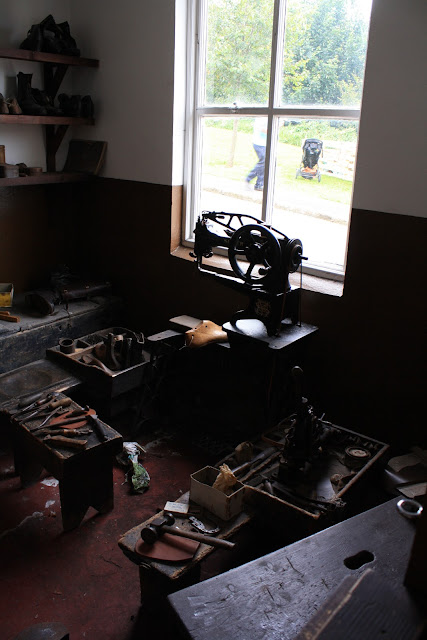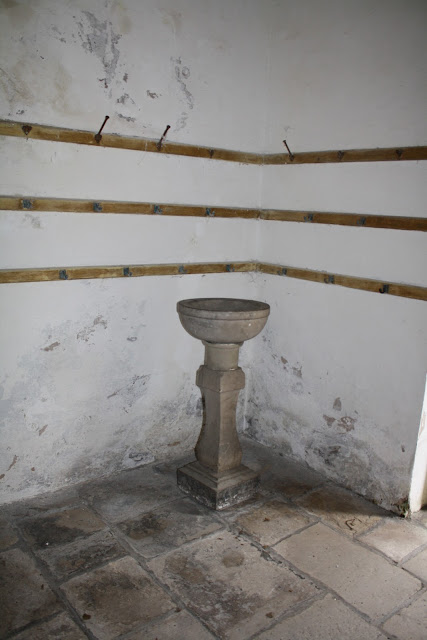"These four houses were built in 1870s as the town of Dromore expanded. In 1903, the larger house at the end of the terrace, with two ground floor rooms, was occupied by a cobbler, Joseph Robert Magill.
His shoe repair business was carried out in the front room and Robert, his wife and their six children occupied the back room and the bedrooms above.
The enterprising Mr Magill acquired the house next door in 1913 and established a small bicycle repair business. The houses were originally part of a larger terrace on the street which led to Dromore’s Presbyterian meeting-house, or church. The other houses in the terrace are smaller, with a single ground floor room and one bedroom upstairs and their room layout is reminiscent of traditional houses in the surrounding countryside.
Although the houses were small, the occupants between 1901and 1911 were all single families, each of either four or five people. Many of the street’s inhabitants worked in local linen mills.
The carpenter's workshop at the end of the terrace is typical of the local craft businesses which catered for the needs of a small town.
Original location: Meeting Street, Dromore, County Down"
These houses have low ceilings and very small rooms. The backyard is a small walled garden that held the coal for the fire and the outhouse, maybe a small garden.
 |
| Meeting Street |
 |
| shoe makers shop |
 |
| shoe maker tools |
 |
| cradle and fireplace |
 |
| kitchen |
 |
| bicycle shop |
 |
| kitchen |
 |
| fireplace |
Church of Ireland
"At the time Kilmore Church was built in 1790, the Church of Ireland was still the Established Church in Ireland, and was supported by tithes. This 10 per cent payment of the annual produce of land or labour was made to the church by the entire population, whether they belonged to it or not.
This small Anglican (Protestant Episcopalian) church was built to accommodate 160 people, although parish records show the usual attendance was about 100 worshipers.
An argument raged throughout the Anglican Communion in the 1840s and 1850s over the nature of worship and the use of rituals introduced by the Anglo-Catholic movement. To heal this rift in the parish, the new rector who was appointed in 1868, built a new church nearby and this building served as a parish hall, a school and a store.
In the 1880s it became common for Anglican churches to replace their box pews with rows of open pews. When Kilmore Church was being moved to the Museum, the layout of the original box pews was clearly visible on the floor and it was decided to reinstate the original 18th century interior.
Original location: Kilmore, Crossgar, County Down"
I have traced my family tree back to 1756 in Ireland. This church was built around that time in history. It helps to see what buildings and living conditions were like in the time you are searching. You get a better scope for how they lived and why they may have left for Canada.
 |
| Church of Ireland |
 |
| kids entering the church |
 |
| box pew |
Northern Bank
"The Northern Banking Company was founded in Belfast in 1824. This was a time when Belfast was beginning to change from a small market town into the great commercial and industrial city it was to become by the end of the century. As the Irish rural economy prospered, banks expanded their branch network throughout most of the century, especially from the late 1840s to the mid-1870s.
Plans for new premises in Portglenone were drawn up in 1910 but construction was postponed by the First World War (1914-1918). The new bank, a modification of two adjoining buildings, opened for business on 14th June 1920.
The building is plain in style, without any ostentation or decoration that might be seen as a misuse of depositors' money, yet it is sufficiently substantial to convey an air of confidence and reliability. The banking premises and the adjoining Manager's house are both lit by gas.
The Bank Manager occupied a position of some importance in the commercial and financial life of the town and district. The first Manager of the Northern Bank in Portglenone was Mr Thomas Edwin James, who held the position from 1920 until his retirement in 1926.
Replica, location of original: Main Street, Portglenone, County Antrim"
 |
| Northern Bank |
 |
| tellers desk |
 |
| parlor |
 |
| pantry |
 |
| kitchen |
 |
| cooking stove |
 |
| sitting room |
 |
| childs room |
 |
| bathroom |
 |
| a flush toilet |
Cushendall Court House and Market
"It appears our forebears has no misgivings about mixing commerce and the law, if this particular building is anything to go by. Built about 1858, it served both as a market house and a Petty Sessions court.
The building is relatively plain in design. Nevertheless, its serious purpose demanded a certain attention to detail. The right-hand chimney is false, built simply to balance the functional chimney on the other gable. Similarly, the right hand door leads to the courtroom upstairs while the left-hand door opens into the market space on the ground floor.
On market days the ground floor provided covered space for stalls and the building was deliberately set back from the roadway to leave space for stock pens.
The first floor courtroom is plainly furnished with a raised bench for the magistrates. In front are tables and seating for the clerks, solicitors and witnesses. The jury, when one was required, sat on benches facing the magistrates and the accused sat on a chair near the windows.
Below the stairs, on the ground floor, is a small cell for defendants awaiting trial or the guilty awaiting transport to prison. The kinds of cases heard in this court were usually minor infringements of the law. Serious cases would have been heard in the County Court.
Original location: Mill Street, Cushendall, County Antrim"
 |
| Cushendall Court House and Market |
 |
| court room |





No comments:
Post a Comment